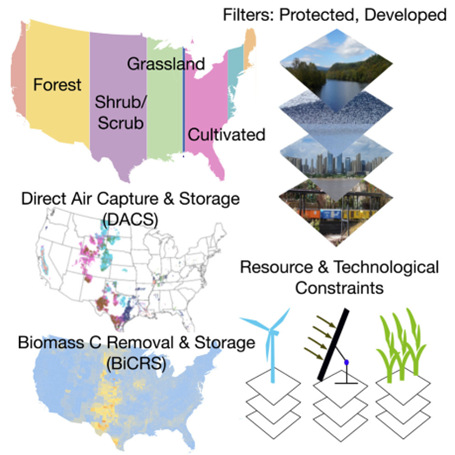Land-based Resources for Engineered Carbon Dioxide Removal in the United States Exceed the Expected Needs
Themes: Sustainability
Keywords: Carbon, Geospatial
Citation
Dai, T., Ellebracht, N.C., Hunter-Sellars, E., Aui, A., Goldstein, H.M., Li, W., Hellwinckel, C.M., Price, L., Wong, A.A., Nico, P., Basso, B., Roberton, G.P., Pett-Ridge, J., Langholtz, M., Baker, S.E., Pang, S.H., Scown, C.D. June 25, 2025 Data from: “Land-based Resources for Engineered Carbon Dioxide Removal in the United States Exceed the Expected Needs.” University of Illinois Urbana-Champaign. DOI: 10.13012/B2IDB-2796463_V1.
Overview

Removing carbon dioxide from the air and storing it underground is a new technology aimed at addressing the impacts of a changing climate. While this technology is promising, it relies on land-based natural resources such as grasses, wind energy, and solar energy, which could interfere with other important activities such as protecting biodiversity conservation, reducing carbon emissions from the power system, and producing food. Our research shows that when choosing biomass carbon removal and storage (BiCRS) and direct air capture and storage (DACS), we can manage land resources in the contiguous United States to achieve carbon neutrality or even negative emissions, without causing land-use conflicts.
Gigatonne-scale atmospheric carbon dioxide removal (CDR), alongside deep emission cuts, is critical to stabilizing the climate. However, some of the most scalable CDR technologies are also the most land intensive. Here, we examine whether adequate land resources exist in the contiguous United States to meet CDR targets when prioritizing grid emissions reduction, food production, and the protection of sensitive ecosystems. We focus on biomass carbon removal and storage (BiCRS) and direct air capture and storage (DACS) and show that suitable lands exceed the expected needs: 37.6 million hectares of land are available for BiCRS, resulting in 0.26 GtCO2 of CDR/year, and 34 million hectares are suitable for wind- and solar-powered DACS, resulting in 4.8 GtCO2 of CDR/year if facilities are co-located with geologic CO2 storage. We identify biomass and energy supply hotspots to meet CDR targets while ensuring land protection and minimizing land competition.
Data
Illinois Data Bank includes:
- Land cover types
- Regional land availability
- Down selecting conditions